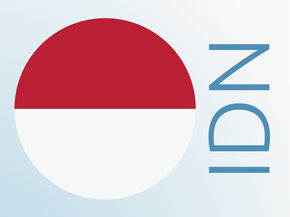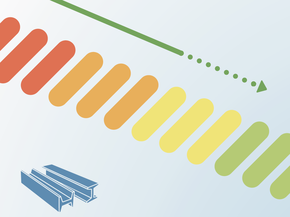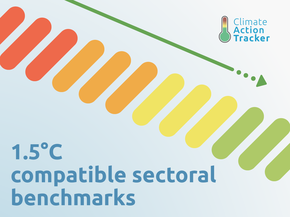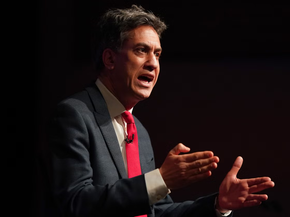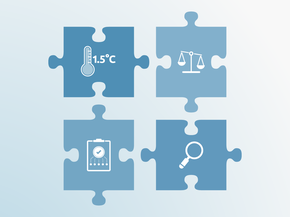Policies & action
Singapore’s current policies are “Insufficient” when compared to modelled domestic pathways. The “Insufficient” rating indicates that Singapore’s policies and action in 2030 need substantial improvements to be consistent with limiting warming to 1.5°C. If all countries were to follow Singapore’s approach, warming would reach over 2°C and up to 3°C.
While CAT modelled domestic pathways do not reflect Singapore’s particularly low domestic RE potential, these pathways do reflect the rapid decarbonisation in the Southeast Asian region that Singapore should follow, if not lead. Given its context, Singapore can play an even larger role in driving regional decarbonisation and energy collaboration.
Policy overview
According to our current policy emissions pathway, Singapore’s GHG emissions dipped in 2020 due to the economic impact of COVID-19 and will steadily rise in the coming years, reaching 56-57 MtCO2e in 2030. Although Singapore’s emissions continue to grow, we project that emissions will be lower in 2030 than its latest NDC target, making a compelling argument for Singapore to raise its level of ambition in its forthcoming NDC. A more ambitious target would demonstrate the government’s commitment to contributing its fair share to global climate change mitigation.
A Future Energy Fund, with an initial reserve of SGD 5bn, was announced in the 2024 budget and aims to support Singapore’s transition to cleaner fuels (CNA, 2024). As part of this announcement, Singapore’s Deputy Prime Minister, Lawrence Wong, highlighted both Singapore’s strategy to import low carbon electricity as well as its National Hydrogen Strategy, released in 2022. Singapore has an opportunity to take regional leadership in the green hydrogen space by becoming a regional hub of storage, trading, and transportation of green hydrogen for other Asian countries (Somani, 2022).
The government introduced a carbon tax in 2019, initially set at SDG 5/tCO2e (USD 4/tCO2e). The carbon tax was increased to SGD 25/tCO2e (USD 19/tCO2e) from 2024 and will be increased to SGD 45/tCO2e by 2026-2027, with a target of reaching SGD 50-80/tCO2e (USD 38-60/tCO2e) by 2030 (National Climate Change Secretariat, 2024a; World Bank, 2023a). The tax currently applies to around 50 facilities in in the manufacturing, power, waste and water sector, and covers 80% of Singapore’s total GHG emissions (National Climate Change Secretariat, 2024a). In 2023, the government released an eligibility list for international carbon credits, which companies are permitted to use to offset up to 5% of the carbon tax liability (National Environment Agency, 2023).
Despite the fivefold increase in 2024, Singapore’s carbon price is still significantly lower than those in Europe and Canada (The World Bank, 2024). The IPCC Working Group III indicates that under 1.5°C pathways, the marginal abatement cost of carbon in 2030 is about USD 220/tCO2 in 2015 terms or USD 281/tCO2 in 2023 terms (IPCC, 2022; World Bank, 2023b). This is 5-7 times higher than Singapore’s intended 2030 carbon price, which equates to USD 38-60/tCO2 in 2023 terms.
Although, pricing carbon needs to be understood in terms of national context, there is a large difference between Singapore’s price and the IPCC 1.5°C pathway range. A carbon tax can encourage more renewable energy in place of fossil fuel energy through changes in relative prices. However, a higher carbon price would need to be implemented earlier, to shift incentives enough to set emissions on a downward trajectory, compatible with the Paris Agreement (Carbon Market Watch, 2017; Warren, 2014).
Singapore’s mitigation strategy is based on three areas: increasing energy and carbon efficiency, reducing carbon emissions in power generation, and developing low-carbon technology (Ministry of the Environment and Water Resources, 2016). Improving energy efficiency across the economy is the backbone of Singapore’s mitigation strategy.
In its latest National Climate Action Plan (Ministry of the Environment and Water Resources, 2016), the government listed a number of policies to improve energy efficiency across all sectors, including an Energy Conservation Act, Green Mark Certification and Energy Labelling schemes, and home appliances Energy Performance Standards, among others. The Government has implemented a target of 80% of buildings to be certified green buildings by 2030. As of 2022, 55% of buildings have met this standard (Building and Construction Authority, 2023).
Sectoral pledges
In Glasgow, a number of sectoral initiatives were launched to accelerate climate action. At most, these initiatives may close the 2030 emissions gap by around 9% - or 2.2 GtCO2e, though assessing what is new and what is already covered by existing NDC targets is challenging.
For methane, signatories agreed to cut emissions in all sectors by 30% globally over the next decade. The coal exit initiative seeks to transition away from unabated coal power by the 2030s or 2040s and to cease building new coal plants. Signatories of the 100% EVs declaration agreed that 100% of new car and van sales in 2040 should be electric vehicles, 2035 for leading markets. On forests, leaders agreed “to halt and reverse forest loss and land degradation by 2030”. The Beyond Oil & Gas Alliance (BOGA) seeks to facilitate a managed phase out of oil and gas production.
NDCs should be updated to include these sectoral initiatives, if they're not already covered by existing NDC targets. As with all targets, implementation of the necessary policies and measures is critical to ensuring that these sectoral objectives are actually achieved.
| Signed? | Included in NDC? | Taking action to achieve? | |
|---|---|---|---|
| Methane | Yes | No | No |
| Coal Exit | Yes | No | No |
| Electric vehicles | No | N/A | N/A |
| Forestry | No | N/A | N/A |
| Beyond Oil and Gas Alliance | No | N/A | N/A |
- Methane pledge: Singapore is one of the signatories of the Global Methane Pledge and committed to reduce methane emissions by 30% by 2030 below 2020 levels. The share of methane in Singapore’s total emissions is around 1.2% and absolute methane emissions have almost remained stable since 2010. Singapore’s energy sector contributes around 80% of its methane emissions.
- Coal exit: During COP26 Singapore joined a coalition of 190 countries that pledge to phase out coal-fired power generation and stop construction of new plants. Singapore has just a single coal plant remaining, has committed to continue phasing out the use of unabated coal in its electricity mix by 2050, and to restrict direct government finance of unabated coal power internationally.
- 100% EVs: Singapore is not a signatory of the pledge on zero emissions car and vehicles by 2040 in COP26. Singapore’s transport sector is dominated by fossil fuel, with oil accounting for 90% of the fuel mix of this sector. Singapore Green Plan 2030 includes a strong push for electric vehicle to achieve 100% electric vehicle by 2040.
- Forestry: Singapore is not a signatory of the declaration on forest and land use. Singapore is a city-state, thus emissions from LULIUCF sector is negligible. Singapore intends that its green spaces would serve as sink, though no specific target is mentioned.
- Beyond oil and gas: this alliance was created with the aim of restricting any kind of fossil fuel expansion by ending licensing of new projects and phasing out existing oil and gas projects. Singapore has no hydrocarbon reserve and imports all its energy requirements. Singapore imports crude oil for its refining and petrochemical industries. Singapore’s petroleum refining, storage, and distribution infrastructure is key to its economy and to global energy trade. Natural gas generated nearly 94% of Singapore’s electricity. Also, Singapore is planning to become an LNG bunkering hub.
Energy supply
Singapore faces multiple challenges while exploring renewable energy sources. An urbanised, high population density coupled with severe land constraints remain a major challenge for Singapore to expand renewable energy projects. Its potential for wind energy is low due to a mean wind speed of less than 2 m/sec, rendering commercial scale wind unviable, and it has no significant river resources to develop hydro energy (Energy Tracker Asia, 2022). Singapore generates more than 94% of its electricity from LNG fired power plants with the full demand met through imports in the absence of any fossil gas reserves within the country (Energy Market Authority, 2023e).
Regardless, Singapore plans on renewables playing a central role in its mitigation strategy for the power sector, specifically residential PV solar, the development of floating PV on rivers and reservoirs and deploying solar on integrated industrial facilities (SG Green Plan, 2021). Despite its land constraints, Singapore has expanded its solar energy capacity in recent years, going from 15.3 MWp of installed Solar-PV capacity in 2013 to 1.17 GWp by end 2023 (Energy Market Authority, 2023f, 2024a). The government is targeting 1.5 GWp of solar power by 2025, and at least 2 GWp of solar power by 2030 (National Environment Agency, 2022).
PUB, Singapore’s National Water Agency, is developing floating solar projects at reservoirs, such as the 1.5 MW systems on both Bedok and Lower Seletar. PUB launched a 1 MW floating solar PV testbed at Tengeh Reservoir in October 2016, and in 2021, a 60 MW system was completed on Tengeh by Semborp (PUB, 2021). Additional policies in the power sector include multiple incentives to expand Waste-to-Energy (WTE) capacity.
Recent announcements demonstrate that Singapore is pursuing grid regionalisation and seeks to use recent LT-LEDS targets to develop regional power grids to access low-carbon electricity in other economies (National Climate Change Secretariat, 2020). Singapore plans to import up to 4 GW of electricity by 2035, which is expected to provide 30% of electricity supply in 2035 (National Environment Agency, 2022). It is also funding large-scale renewable projects internationally in support of this goal (APEC, 2022).
The Energy Market Authority (EMA) has set a carbon intensity target of < 0.15 tCO2e/MWh within 5 years of commercial operations for imported electricity (Energy Market Authority, 2023d, 2023a). Conditional approval has been granted by the EMA for proposed imports totalling 1 GW from Cambodia, 2 GW from Indonesia and 1.2 GW from Vietnam (Energy Market Authority, 2024b).
The imported electricity is proposed to be generated from a mix of solar, hydro, wind, and supported by battery storage. Several import trials have already commenced or are planned. This includes the Lao PDR-Thailand-Malaysia-Singapore Power Integration Project (LTMS-PIP), which commenced in June 2022, intending to import up to 100 MW of hydropower.
A second trial will commence in 2024, for a period of two years, and will import 100 MW from Malaysia. Sun Cable is also planning to deliver 1.75 GW of solar PV power from Australia to Singapore via a 4300 km subsea cable through its flagship project AAPowerLink (Sun Cable, 2023).
While the government’s targets for solar and low-electricity imports are encouraging, this is undermined by planned expansions in LNG imports and gas-fired generation. The EMA intends to import an additional 1 Mtpa of LNG between 2023-2027 (Energy Market Authority, 2022a). While 1 GW of gas-fired generation capacity is expected to be retired over the next five years, this is far exceeded by planned capacity additions. 1.88 GW of new capacity has already been sanctioned, coming online in 2025-26, and the EMA is calling for an additional 600 MW, at least, to be added by 2028 (Energy Market Authority, 2023c).
Mixed signals from policymakers to the public and industry around Singapore’s mitigation effort have resulted in decisions that are expected to increase, rather than reduce emissions, which has been cemented by Singapore’s aspiration to become a world LNG Bunker fuel and storage nation. Fossil gas needs to be phased out completely under a Paris-compatible pathway (Climate Analytics, 2021). The high dependency on fossil gas imports makes Singapore’s energy security vulnerable, and now even more so in the context of the current volatility of global energy market (Argus Media, 2022). Processes like gas liquefaction, transportation, and regasification also significantly increase Singapore’s carbon footprint and reduce its emissions reduction potential.
The government is also expecting significant growth in electricity demand at 3.4% per year between 2023-2028, compared to the historic average of 1.5% between 2013-2022. This is attributed to growth in existing electricity-intensive sectors as well as emerging sectors such as the advanced manufacturing, digital economy, food and transport sectors (Energy Market Authority, 2023c).
The government-controlled Development Bank of Singapore (DBS) in April 2019 announced that it would stop funding new coal-fired power stations globally. DBS has made further positive signals, committing to reducing thermal coal exposure and reaching net zero by 2039 (DBS Bank, 2021). In 2023, the Monetary Authority of Singapore (MAS) launched a coalition and two pilot projects to test the use of transition credits for the early retirement of coal-fired power plants, replaced by clean energy sources. The two pilot projects relate to coal plants in the Philippines (Monetary Authority of Singapore, 2023a).
The MSA also launched the Singapore-Asia Taxonomy for Sustainable Finance at the end of 2023. The Taxonomy includes thresholds and criteria for both green and transition activities, with sunset dates for transition thresholds (Monetary Authority of Singapore, 2023b).
Singapore is exploring how emerging low-carbon solutions such as carbon capture, utilisation, and storage technologies (CCUS), and green hydrogen can help it reduce its emissions intensity (National Climate Change Secretariat, 2020). The National University of Singapore, for example, has partnered with Sembcorp Industries, to establish an SGD 25 million research institute, aiming to produce green hydrogen and hydrogen carriers for storage and transport (The Straits Times, 2022a).
During the announcement of the net zero year, Deputy Prime Minister Lawrence Wong pointed to “low-carbon hydrogen" being an increasingly promising solution for Singapore, launching the National Hydrogen Strategy to scale up low-carbon hydrogen investment and deployment (Energy Market Authority, 2022c). However, the government defines "low carbon” hydrogen as both green hydrogen, produced via electrolysis with renewable power, and blue hydrogen, produced from fossil fuels with CCUS (Ministry of Trade and Industry Singapore, 2022).
Industry
In 2021, Singapore’s industrial sector accounted for 44.4% of its primary emissions, plus 16.6% of secondary emissions from electricity use (National Climate Change Secretariat, 2024). Singapore´s mitigation strategy for the industry sector is based on increasing energy and carbon efficiency. The main policies are the Energy Conservation Act from 2013, which mandates monitoring and reporting energy usage and GHG emissions for large energy users; the Energy Efficiency Fund (E2F), which provided grants and tax incentives for energy efficiency investments in industrial processes; and the Energy Efficiency National Partnership Programme (EENP), which is a learning network for companies in the industrial sector to learn about energy efficiency ideas, technologies, practices, and standards (National Environment Agency, 2020).
In 2017, the Energy Conservation Act (ECA) was enhanced, requiring, from 2018 onwards, the energy users it covers to have their monitoring plans verified by an independent third party and appoint a GHG manager (National Environment Agency, 2017). From 2021 onwards, these companies must establish a structured energy management system, and periodically assess energy efficiency opportunities at existing industrial facilities. In 2018, minimum energy performance standards were introduced to phase out the least efficient industrial electric motors and expanded to other common industrial equipment and systems thereafter (National Environment Agency, 2018).
In the context of Singapore’s 2018 Climate Action Year, over 450 organisations, including industrial manufacturers, made voluntary commitments to improve their carbon footprint or increase awareness on climate change-related issues, such as upgrading existing equipment (e.g. chillers, lightings, appliances) with more energy efficient models, or starting recycling and waste management programmes. Given the voluntary nature of the pledges, and the lack of information to translate these targets into emission reduction targets, we have not included these in our current policy projections.
The Sustainable Jurong Island report, which outlines targets and aspirations to decarbonise Singapore’s Energy & Chemical (E&C) hub, is targeting 2 Mt of carbon capture, utilisation and storage (CCUS) by 2030. (Singapore Economic Development Board, 2021)
In December 2023 the government signed an agreement with ExxonMobil and Shell to "coordinate the planning and development of a CCS project, capable of capturing and permanently storing at least 2.5 million tons of CO2 a year, by 2030." Storage sites have not yet been selected and no details were included regarding capture facilities or transport infrastructure (Singapore Economic Development Board, 2024). Given the early phase of the consortium development and the track record of CCS across the world to date, including high costs and protracted development times, this is an ambitious target.
Other developments on Jurong Island include a 285 MWh battery energy storage system, which surpasses Singapore’s target of 200 MWh energy storage by 2025, and Singapore’s first hydrogen-ready power plant, which will be operational by 2026 and is designed to operate initially on 30% hydrogen gas. A tender to install solar PV on 60 hectares of interim vacant land and the rooftops of five buildings on Jurong Island has also been initiated as part of the SolarRoof and SolarLand programs, following an initial pilot on 3.9 hectares of land (Energy Market Authority, 2023b).
Transport
Singapore’s transport sector made up 14.2% of total emissions in 2021 (National Climate Change Secretariat, 2024b). Singapore aims to develop a greener and more sustainable land transport sector, reducing peak land transport emissions by 80%, by or around mid-century. The sector’s energy demand and associated emissions are expected to flatten out as a result of measures to promote public transport, modal shifts, and improve the emissions intensity of road transport. The government estimates that implemented measures reduced emissions by 1.67 MtCO2e in 2020 (National Environment Agency, 2022).
Singapore aims to phase out Internal Combustion Engine (ICE) vehicles by 2040 (National Environment Agency, 2022). However, to be compatible with the 1.5°C long-term temperature goal, the last fossil fuel car should be sold in 2035 at the latest (Climate Action Tracker, 2016).
The Vehicle Emissions Scheme (VES) was introduced in 2018, replacing the Carbon Emissions-based Vehicle Scheme (CEVS), which provided rebates for low-emission cars and imposed surcharges on high-emission cars. The VES expanded the range of pollutants covered to include hydrocarbons (HC), carbon monoxide (CO), nitrogen oxides (NOX), and particulate matter (PM) (National Environment Agency, 2022).
Fuel economy labels have been redesigned to include information on each vehicle’s VES band. To further promote the adoption of cleaner vehicles, the VES was enhanced with increased rebates and higher surcharges from January 2021. Starting from 2021 all new and used petrol or diesel vehicles must comply with the Euro VI emission standards (National Environment Agency, 2022).
The Singapore Green Plan 2030 includes a strong push to electrify the vehicle fleet, which would help Singapore achieve its vision of 100% cleaner energy vehicles by 2040 (Land Transport Authority, 2021). Singapore has introduced tax incentives to lower the upfront and running costs of electric vehicles (EVs) such as the Electric Vehicle Early Adoption Incentive (EEAI) (National Environment Agency, 2022). As of 2023, less than 2% of the vehicle population were fully electric or plug-in hybrid electric vehicles (PHEVs) (Land Transport Authority, 2023).
Under the new VES standards, CO2 emissions produced by electricity generation from fossil fuels are accounted for by applying an emissions factor to the electricity consumption of EVs and PHEVs (National Climate Change Secretariat, 2018b).
Since February 2018, the growth of private vehicles has been effectively capped, when the permissible growth rate of private vehicle population was reduced from 0.25% to 0% (National Environment Agency, 2018). Prospective vehicle owners must bid and pay for a Certificate of Entitlement which allows them to purchase a vehicle and use it for 10 years (National Environment Agency, 2022).
Singapore is encouraging active transport and modal shift in its Land Transport Master Plan (LTMP) 2040 by developing infrastructure, creating more urban space for walking and cycling, and expanding the MRT system (Singapore’s metro). The Land Transport Authority (LTA) announced SGD 1bn in funding over the next decade to support Walk, Cycle, Ride journeys. By 2030, it aims to extend the country’s cycling path network to more than 1000 km, compared to 460 km in 2020 (National Environment Agency, 2022). As of 2019, there were cycling networks in nine out of 24 public housing towns and 200 km of sheltered walkways(National Environment Agency, 2018).
Singapore plans to increase the length of the rail network from 245 km in 2022 to about 360 km in the early 2030s so that eight in ten households will be within a ten-minute walk of a train station. Singapore is targeting a mass public transport modal share of 75% during the morning and evening peak hours by 2030 (National Environment Agency, 2022).
The Land Transport Master Plan sets a goal for all public buses and taxis to run on cleaner energy sources by 2040 (Republic of Singapore, 2019), and the Land Transport Authority (LTA) aims to have half of its public bus fleet be electric by 2030 (Land Transport Guru, 2022). In 2016, Singapore trialled e-buses, and by 2018, 60 trial e-buses were on the roads (Republic of Singapore, 2019). Around 700 electric taxis have been rolled out by the private taxi operators (The Straits Times, 2021, 2022b).
We exclude emissions from marine and aviation bunkers when assessing Singapore’s NDC target and current policies. These emissions are more than three times higher than the rest of Singapore's emissions—with the vast majority being related to Singapore’s role as a hub in international shipping (National Environment Agency, 2022).
Buildings
As of 2021, Singapore´s buildings sector accounted for 0.9% of emissions, from energy combustion related to commercial and residential sub sectors and their cooking and hot water systems (National Climate Change Secretariat, 2024b). Emissions from electricity use, such as for air conditioning or appliance use, is not accounted for in primary emissions from the buildings sector but made up a further 12.6% of national emissions (within electricity).
The government’s mitigation strategy for the sector is based on increasing energy efficiency. The main policy for the sector is the Green Mark Scheme, which encourages developers and owners to build and maintain greener buildings and requires the achievement of a 28% energy efficiency improvement from 2005 building codes for new and existing buildings undergoing major retrofitting works (with a gross floor area of 2,000 m2 or more). The Green Building Masterplan, first rolled out in 2006 with several subsequent updates, contains several initiatives aimed at increasing energy efficiency and reducing energy demand in buildings (APEC, 2022). In 2018, the Building Control Act launched the Super Low Energy (SLE) Building programme to encourage firms to go beyond the existing Green Mark Platinum standards and push the envelope of environmental sustainability in Singapore.
The fourth edition of Singapore’s Green Building Masterplan (SGBMP), launched in 2021, aims to deliver against three key targets dubbed “80-80-80 in 2030”- greening 80% of Singapore’s buildings, 80% of new developments to be Super Low Energy (SLE) buildings from 2030 and achieving 80% improvement in energy efficiency for best-in-class green buildings by 2030 (Building and Construction Authority, 2023; SG Green Plan, 2021). As of end 2022, 55% of Singapore’s buildings by floor area had been “greened” (Building and Construction Authority, 2023).
Since 2013, the Building Control Act has required all existing buildings with a gross floor area of 15,000 m2 or more to achieve the minimum Green Mark standard after retrofitting. Audits are conducted every three years and companies have to submit energy consumption and energy-related building data (National Climate Change Secretariat, 2018a).
Singapore has adopted a Mandatory Energy Labelling Scheme (MELS), which encourages households to buy energy-efficient appliances, and Mandatory Energy Performance Standards (MEPS), to ensure energy inefficient appliances are discontinued (Republic of Singapore, 2019).
Waste
Singapore recovers heat from the incineration of waste to produce electricity. In 2020, waste to energy provided about 2.3% of Singapore’s total electricity generated (National Environment Agency, 2022). Yet, the waste sector just accounts for 0.6% of Singapore’s total emissions (National Environment Agency, 2018). To raise awareness of waste issues and the need to recycle resources Singapore declared 2019 as “Year Towards Zero Waste“ (Ministry of the Environment and Water Resources, 2019a). In the same year, the government launched the Zero Waste Masterplan detailing strategies to reduce waste sent to Semakau Landfill by 30% by 2030, extending the landfill’s lifespan beyond 2035 and reducing incineration emissions (Ministry of the Environment and Water Resources, 2019b).
The government also introduced the Resource Sustainability Act 2019 to enforce mandatory packaging data reporting by 2020, Extended Producer Responsibilities for e-waste by 2021 and mandatory food waste segregation for treatment from 2024, and Extended Producer Responsibility for packaging, including plastics by 2025 (Ministry of the Environment and Water Resources, 2019b).
The government aims to increase the waste recycling rate from 52% in 2022 to 70% by 2030 (National Environment Agency, 2022).
Further analysis
Latest publications
Stay informed
Subscribe to our newsletter

